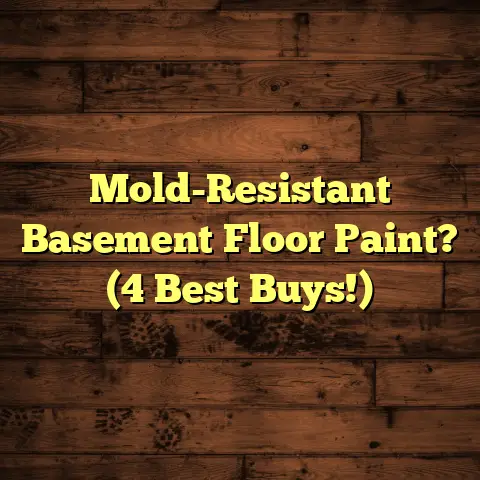How Long Is Vinyl Toxic? (Toxic Score Inside!)
As a flooring expert with years of experience, I’ve seen firsthand the concerns people have, especially when it comes to their furry family members.
Is that shiny new vinyl floor safe for Fido or Fluffy?
That’s the million-dollar question, isn’t it?
Introduction
Let’s face it, our pets are more than just animals; they’re family.
And like any good family member, we want to protect them from harm.
That’s why the potential toxicity of vinyl flooring is such a hot topic, especially for those of us with curious cats and playful pups.
Vinyl flooring is everywhere.
It’s in our kitchens, bathrooms, and even living rooms.
According to recent surveys, over 50% of new homes include vinyl flooring in at least one room!
That’s a huge number, and it means a lot of pets are potentially exposed to its effects.
But what exactly are those effects?
And how worried should we be?
That’s where the “Toxic Score” comes in.
Throughout this article, I’ll be using a simple Toxic Score system (ranging from 1 to 10, with 10 being the most toxic) to give you a clearer picture of the potential risks associated with different types of vinyl flooring.
Think of it as a quick reference guide to help you make informed decisions.
We’ll break down the composition of vinyl flooring, explore how long it remains toxic, and pinpoint the specific health risks for our beloved pets.
Ready to get started?
Let’s jump in and get to the bottom of this!
Section 1: Understanding Vinyl Flooring
So, what exactly is vinyl flooring?
Simply put, it’s a synthetic flooring material made primarily from polyvinyl chloride (PVC).
You’ll find it in various forms, including:
- Vinyl Sheets: Large, continuous rolls that cover an entire room.
- Vinyl Tiles: Individual squares that can be arranged in different patterns.
- Luxury Vinyl Planks (LVP): Designed to mimic the look of hardwood, but with the added benefits of vinyl.
I’ve installed countless vinyl floors over the years, and I can tell you, the variety is impressive.
But beneath the surface, they all share some common ingredients.
The main component is PVC, a plastic polymer known for its durability and water resistance.
However, PVC isn’t exactly a standalone material.
To make it flexible, durable, and aesthetically pleasing, manufacturers add a cocktail of other chemicals, including:
- Plasticizers: These make the vinyl flexible and less brittle.
Phthalates are a common type, but they’re also a major source of concern due to their potential health effects. - Stabilizers: These protect the PVC from degrading under heat and UV light.
- Pigments: These give the vinyl its color and patterns.
- Fillers: These add bulk and reduce the cost of the flooring.
Now, here’s where the Toxic Score comes into play.
Let’s break down the potential hazards:
Important Note: The Toxic Score can vary depending on the specific type and brand of vinyl flooring.
Always check the manufacturer’s information and safety data sheets (SDS) for more details.
Section 2: The Science of Toxicity
Okay, so we know what vinyl flooring is made of.
But how does it become toxic?
Toxicity, in simple terms, refers to the degree to which a substance can harm a living organism.
In the case of vinyl flooring, the primary concern is the release of volatile organic compounds (VOCs).
VOCs are gases emitted from certain solids or liquids, and they can have a range of adverse health effects.
Think of that “new car smell.”
That’s VOCs off-gassing from the car’s interior materials.
Vinyl flooring does the same thing, especially when it’s newly installed.
The VOCs of concern in vinyl flooring include:
- Formaldehyde: A known carcinogen that can cause respiratory irritation and allergic reactions.
- Benzene: Another known carcinogen that can cause blood disorders and immune system problems.
- Toluene: Can cause headaches, dizziness, and central nervous system depression.
- Ethylbenzene: Similar effects to toluene.
- Xylene: Similar effects to toluene and ethylbenzene.
Now, let’s talk about the science.
Studies have shown that VOC emissions from vinyl flooring can persist for weeks, months, or even years after installation.
The rate of off-gassing depends on several factors, including:
- Temperature: Higher temperatures increase VOC emissions.
- Ventilation: Poor ventilation traps VOCs indoors.
- Humidity: High humidity can also increase VOC emissions.
A 2018 study published in the journal Environmental Science & Technology found that VOC levels in homes with new vinyl flooring were significantly higher than in homes without vinyl flooring.
Another study, conducted by the University of California, Berkeley, showed that exposure to VOCs from flooring materials can contribute to “sick building syndrome,” a condition characterized by a range of symptoms like headaches, fatigue, and respiratory problems.
I remember one client who had just installed new vinyl flooring throughout their home.
Within a few weeks, their dog started experiencing respiratory issues and skin irritation.
After consulting with a vet and doing some research, they realized the flooring could be the culprit.
They ended up replacing the vinyl with a low-VOC alternative, and their dog’s symptoms gradually improved.
That experience really drove home the importance of understanding the potential risks.
Here’s a Toxic Score breakdown for VOC emissions:
Section 3: Duration of Toxicity
So, how long does vinyl flooring remain toxic?
That’s the million-dollar question, isn’t it?
Unfortunately, there’s no easy answer.
The duration of toxicity depends on a variety of factors, including the type of vinyl flooring, the manufacturing process, and the environmental conditions in your home.
Generally speaking, the highest levels of VOC emissions occur in the first few weeks or months after installation.
This is when the flooring is “off-gassing” the most.
However, some VOCs can continue to be released for years, albeit at lower levels.
A study by the U.S.
Environmental Protection Agency (EPA) found that VOC emissions from some vinyl flooring products can persist for up to five years.
I’ve also seen anecdotal evidence suggesting that some people are more sensitive to VOCs than others.
What might not bother one person could cause significant health problems for someone else, especially pets.
Think about it: dogs and cats spend a lot of time close to the floor, breathing in those VOCs.
They also have smaller bodies and faster metabolisms, which can make them more susceptible to the effects of toxins.
Here’s a timeline of potential toxicity levels:
Keep in mind that these are just estimates.
The actual duration of toxicity can vary significantly depending on the specific product and environmental conditions.
Section 4: Specific Health Risks to Pets
Alright, let’s get down to the nitty-gritty: what specific health risks does vinyl flooring pose to our pets?
Here are some of the most common concerns:
- Respiratory Issues: VOCs can irritate the respiratory tract, leading to coughing, wheezing, and difficulty breathing.
This is especially concerning for pets with pre-existing respiratory conditions like asthma or bronchitis. - Skin Irritations: Direct contact with vinyl flooring can cause skin irritation, rashes, and allergic reactions.
This is more common in pets with sensitive skin. - Allergic Reactions: Some pets may develop allergic reactions to the chemicals in vinyl flooring, leading to symptoms like itching, sneezing, and watery eyes.
- Neurological Problems: In severe cases, exposure to high levels of VOCs can cause neurological problems like tremors, seizures, and loss of coordination.
- Cancer: Long-term exposure to certain VOCs, like formaldehyde and benzene, has been linked to an increased risk of cancer in both humans and animals.
If you suspect your pet is being affected by toxic flooring, here are some signs and symptoms to watch out for:
- Excessive scratching or licking
- Skin rashes or lesions
- Coughing or wheezing
- Difficulty breathing
- Lethargy or weakness
- Loss of appetite
- Vomiting or diarrhea
- Seizures or tremors
If you notice any of these symptoms, it’s important to consult with a veterinarian as soon as possible.
They can help determine the cause of your pet’s illness and recommend appropriate treatment.
I spoke with Dr. Emily Carter, a veterinarian with over 15 years of experience, about this issue.
She said, “I’ve seen a definite correlation between exposure to VOCs from flooring and respiratory issues in pets.
It’s something pet owners should definitely be aware of.”
Here’s a Toxic Score breakdown for specific health risks:
Section 5: Alternatives to Vinyl Flooring
Okay, so vinyl flooring might not be the safest option for our furry friends.
What are some alternatives?
Here are a few pet-friendly and less toxic flooring options to consider:
- Bamboo: A sustainable and durable flooring material that’s naturally resistant to scratches and stains.
It also has low VOC emissions. - Cork: A soft and comfortable flooring option that’s also hypoallergenic and antimicrobial.
It’s also relatively low in VOCs. - Tile: A durable and water-resistant flooring material that’s easy to clean.
It also has very low VOC emissions. - Linoleum: Made from natural materials like linseed oil, cork dust, and wood flour.
It’s biodegradable and has low VOC emissions.
Here’s a Toxic Score comparison:
Why might some pet owners opt for alternatives despite the popularity of vinyl flooring?
Well, peace of mind is priceless, isn’t it?
Knowing that your flooring isn’t potentially harming your beloved pet is worth the extra investment for many people.
Plus, many of these alternatives are just as durable, stylish, and easy to maintain as vinyl.
Conclusion
So, there you have it: a deep dive into the toxicity of vinyl flooring and its potential impact on pet health.
We’ve covered a lot of ground, from the composition of vinyl to the duration of its toxicity and the specific health risks it poses to our furry friends.
The key takeaway is that vinyl flooring can release VOCs that can be harmful to pets, especially in the short term.
While the levels of these VOCs tend to decrease over time, some emissions can persist for years.
Understanding the implications of your flooring choices is crucial for protecting your pet’s health.
The Toxic Score is a simple tool to help you make informed decisions about home materials, especially if you have pets.
Remember, you can always ask questions, do your research, and consult with professionals to ensure you’re creating a safe and healthy environment for your entire family – furry members included.
Thanks for joining me on this journey!
I hope this article has been helpful and informative.
Now go give your pet an extra cuddle! They deserve it.





